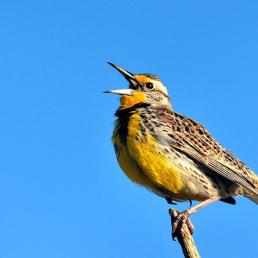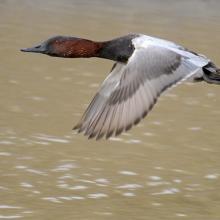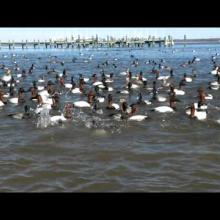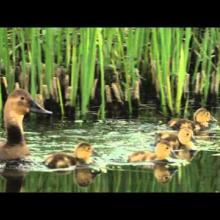

Join BirdNote tomorrow, November 30th!
Illustrator David Sibley and actor H. Jon Benjamin will face off in the bird illustration battle of the century during BirdNote's Year-end Celebration and Auction!
While nearly a third of North American bird species are in decline, many birds that depend on wetlands are thriving. Duck breeding populations in 2009 were an estimated 25% above historical averages. Conditions on the breeding grounds have improved since the drought years of the 1980s, but human action has also made a huge difference. You can help by purchasing a duck stamp every year. Adam Grimm's painting of a pair of Canvasbacks won the contest for the 2014-2015 duck stamp.
BirdNote®
Wetland Birds Thrive
Written by Todd Peterson
This is BirdNote.
[Dawn song of birds in a freshwater marsh]
While nearly a third of North American bird species are in decline, many birds that depend on wetlands are thriving.
[Call of Redheads]
The main determinant of duck breeding success is the condition of wetlands and upland habitat on the prairies and in the boreal forest. After the extended droughts of the 1980s, conditions on the breeding grounds improved when the rains returned. And, waterfowl hunters, through organizations like Ducks Unlimited, have provided hundreds of millions of dollars to conserve and restore wetlands.
It’s not just ducks that benefit. Nearly one quarter of US birds, such as this Virginia Rail, rely on freshwater wetlands.
[Calls of Virginia Rail]
Yes, challenges remain. Breeding habitat in the prairie pothole region is under increasing pressure for conversion to agriculture. But wetland birds respond to our efforts. For example, in spring, in wetland-rich areas protected by conservation programs in the Dakotas, you can find more than 100 breeding pairs of ducks on a single square mile of prairie.
[Quacking of hen Mallard]
Learn more at Birdnote.org.
Support for BirdNote is provided by Wendy and David Close from Clinton, Washington — and generous listeners around the world.
###
Bird sounds provided by The Macaulay Library of Natural Sounds at the Cornell Lab of Ornithology, Ithaca, New York. Dawn chorus at Malheur National Wildlife Refuge [uned] recorded by G.F. Budney; quacking of hen Mallard [3420] by A.A. Allen; calls of Redheads [59598] by W.W.H. Gunn; call of Virginia Rail [107435] by W.L. Hershberger.
BirdNote's theme music was composed and played by Nancy Rumbel and John Kessler.
Producer: John Kessler
Executive Producer: Chris Peterson
© 2016 Tune In to Nature.org March 2014/2016/2020 July 2023
Narrator: Michael Stein
ID# SotB-wetlands-01b-2020-3-6 SotB-wetlands-01b
https://www.ducks.org/conservation/waterfowl-surveys/2023-duck-numbers
Young, Matt. “Rescuing the Duck Factory”, Ducks Unlimited magazine. November/December 2008. P.71







